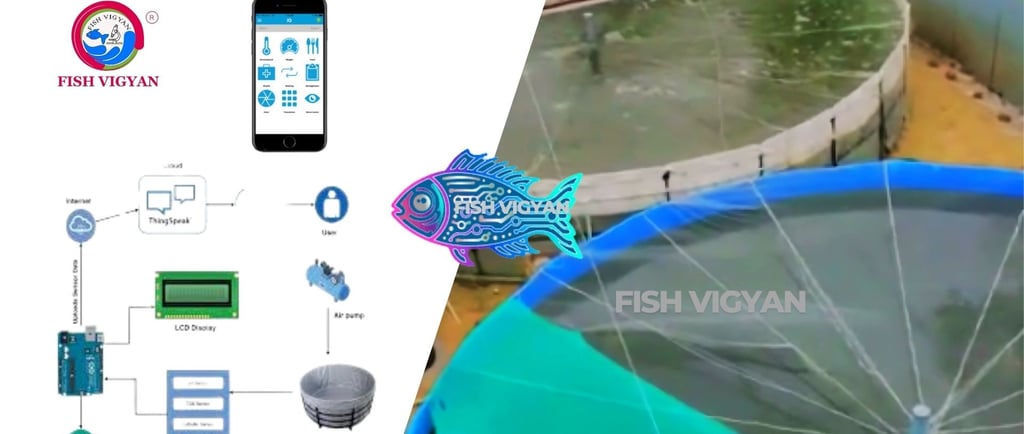The Future of Fish Farming: Trends and Innovations
Fish farming, or aquaculture, is a sustainable solution to meet the growing seafood demand as wild stocks decline. Technological advancements are enhancing efficiency, sustainability, and profitability in the industry.


1. Sustainable Aquaculture Practices
Sustainability is the future of aquaculture, as concerns about environmental impact, water pollution, and biodiversity loss continue to rise. Here are some sustainable practices being adopted globally:
a. Biofloc Fish Farming
Biofloc technology (BFT) is an innovative aquaculture system that enhances water quality by promoting beneficial microbial communities. These microbes help convert fish waste into protein-rich feed, reducing the need for external feed sources. Biofloc systems improve biosecurity, reduce water exchange requirements, and lower overall production costs. This method requires fewer technical skills, less equipment, and has low maintenance and operational costs, making it more affordable and accessible to small-scale and mass fish farmers.
b. Recirculating Aquaculture Systems (RAS)
RAS is a groundbreaking technique that allows fish to be farmed in a closed-loop system where water is continuously filtered and reused. This significantly reduces the need for large water bodies, minimizes waste discharge, and enhances biosecurity. However, RAS requires higher technical skills, costly equipment, and high electricity expenditure, making it a better option for large-scale commercial operations rather than small-scale farmers.
c. Integrated Multi-Trophic Aquaculture (IMTA)
IMTA involves farming different species together in a way that they benefit from each other’s presence. For example, fish, shellfish, and seaweed can be grown together, with fish providing nutrients for the plants while shellfish filter the water. This reduces waste, promotes biodiversity, and increases farm productivity.
d. Organic and Eco-Friendly Feed Alternatives
Traditional fish feed relies on fishmeal and fish oil, which can contribute to overfishing. The industry is now shifting towards sustainable feed alternatives, such as:
Insect-based protein: Black soldier fly larvae and mealworms offer a high-protein, eco-friendly alternative.
Algae-based feed: Rich in omega-3 fatty acids, algae-based feeds eliminate the need for fishmeal.
Plant-based feed: Soy, peas, and other plant proteins are being optimized for better digestibility and nutrient absorption.
2. Offshore and Open-Ocean Aquaculture
To overcome the limitations of land-based and nearshore aquaculture, many companies are investing in offshore and open-ocean fish farming. These farms are set up in deeper waters with stronger currents, which help improve water quality and reduce the environmental impact.
a. Submersible Fish Cages
These advanced cages can be lowered to different depths, allowing fish to live in optimal conditions. They also protect fish from predators and extreme weather conditions.
b. Autonomous Aquaculture Facilities
Self-sustaining offshore fish farms, powered by renewable energy, are being developed to reduce dependence on land-based resources. These facilities use AI, IoT, and robotics for feeding, monitoring, and maintenance.
3. Technological Innovations in Aquaculture
Modern fish farming is increasingly dependent on technology to enhance efficiency and sustainability. Some key innovations include:
a. Artificial Intelligence (AI) and Big Data
AI-powered systems help monitor fish behavior, detect diseases, and optimize feeding schedules. Big data analytics also assist in predicting fish growth rates, improving yield forecasting, and minimizing resource wastage.
b. Internet of Things (IoT) and Smart Sensors
IoT devices and smart sensors provide real-time data on water quality, temperature, oxygen levels, and fish health. Farmers can receive instant alerts via mobile apps, allowing them to take immediate action to prevent fish mortality and maximize productivity.
c. Blockchain for Transparency and Traceability
Blockchain technology ensures transparency in the seafood supply chain, allowing consumers to trace the origin of their seafood. This helps prevent fraud, ensures food safety, and builds consumer trust in farmed fish products.
4. Genetic Advancements in Fish Farming
Genetics plays a crucial role in improving fish health, growth rates, and resistance to diseases. Selective breeding programs focus on producing healthier, faster-growing fish with higher nutritional value. Additionally, gene-editing techniques such as CRISPR are being explored to enhance desirable traits while reducing vulnerability to diseases.
5. Climate-Resilient Aquaculture
Climate change poses significant challenges to fish farming, including rising water temperatures, ocean acidification, and extreme weather events. To combat these challenges, researchers are developing climate-resilient fish species that can adapt to varying environmental conditions.
a. Temperature-Resistant Fish Strains
Genetic research is helping create fish strains that can tolerate higher temperatures, ensuring stable production even in warmer climates.
b. Alternative Aquaculture Locations
Floating fish farms and inland aquaculture systems are being explored to reduce dependency on climate-sensitive coastal areas.
6. Future of Lab-Grown Fish and Cellular Aquaculture
One of the most revolutionary innovations in fish farming is cellular aquaculture, where fish meat is grown in a lab using stem cells. This process eliminates the need for traditional fish farming while ensuring a high-quality, sustainable protein source. Although still in the early stages, lab-grown fish could significantly reduce pressure on marine ecosystems.
7. Policy and Regulatory Advancements
Governments and international organizations are implementing stricter regulations to promote sustainable fish farming. Certification programs like ASC (Aquaculture Stewardship Council) and MSC (Marine Stewardship Council) help consumers make informed choices by identifying responsibly farmed seafood.
Conclusion
The future of fish farming is being shaped by sustainability, technology, and innovation. From AI-driven monitoring systems to climate-resilient fish strains and lab-grown seafood, the industry is evolving to meet global food demands while protecting marine ecosystems. By adopting these trends and innovations, fish farming can play a vital role in securing a sustainable and nutritious food supply for future generations.
